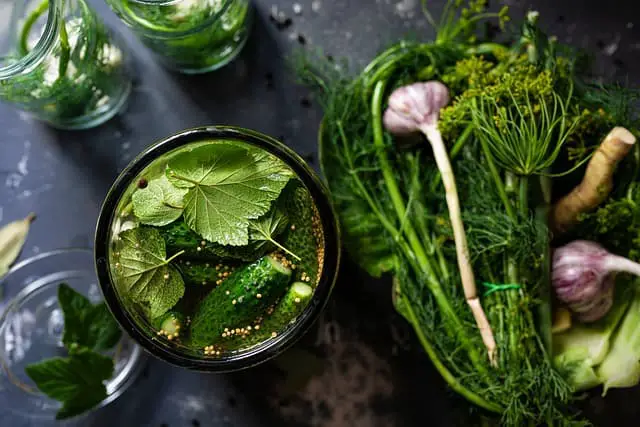Not sure whether the pickles you have in your jars are raw or cooked?
This article discusses what pickles are, how they are made, whether they are cooked or not and even explores if pickling itself is considered as a method of cooking.

What are pickles?
Pickles are basically fermented vegetables, which means they are vegetables that are submerged in a highly acidic solution for an extended period of time such that their taste, flavor and appearance are affected, and also their shelf life is improved.
Pickles in the United States generally refers to small cucumbers that are soaked in a brine solution for sometime before they are consumed.
Are pickles cooked?
Whether or not pickles are cooked depends on the type of vegetable that is being pickled.
Some vegetables can be consumed as they are and so there is no need to pickle them since the pickling process itself will soften the vegetables and make them edible.
On the other hand, some vegetables cannot be enjoyed as they are and must be cooked in order to become enjoyable after pickling: famous examples include asparagus, broccoli and green beans.
The vegetables, in practice, aren’t even actually cooked but rather blanched, and then shocked in the hot mixture of vinegar, water and salt in order to continue softening (if the fresh pack method is used for the curing). If the fermentation method is used however, then blanching becomes the only heating they undergo, and the rest of the softening is done by the acid in the brine.
One of the advantages of cooking some vegetables prior to pickling is that they would pickle with a firm texture and also preserve their color.
What are pickles made from?
Broadly speaking, there are two main techniques for making pickles.
The first one is the fermentation method while the second one is the fresh pack method or non-fermentation method.
Let’s go through them carefully so you understand the difference between the two.
Fermented Pickles
Fermented pickles (as the name suggests) are cured or soaked in a solution that ferments them.
Fermentation basically produces an end result that has a sour taste due to the action of bacteria consuming the carbohydrates in the food and turning them to lactic acid, alcohol and carbon dioxide.
It is the lactic acid component that gives the pickle its sour taste, and also helps preserve the pickle for longer duration by preventing the growth of harmful bacteria (through increasing the acidity of the medium) while simultaneously supporting the growth of beneficial bacteria.
In fermented pickles, the vegetables are submerged in a brine solution, which consist of water and salt in defined proportions.
There are many recipes that play around with the ratios DEPENDING on the quantity of vegetables intended to be pickled, but one must never alter the ratios of a TESTED recipe otherwise they’re signing up for disaster while pickling.
The wrong amount of salt content can lead to the growth of mold and also allow harmful bacteria to thrive and cause spoilage of the vegetable as well as increase the risk of illness.
After the vegetables are submerged in the brine solution contained in a jar, or the brine poured over the vegetables contained in the jar, either way, the mouth of the jar is covered with a clean cloth held in place using a rubber band and the jar is allowed to sit for 2 to 4 weeks depending on how sour the resulting product is required to be.
The use of a non-airtight cover is recommended as carbon dioxide gas builds up in the container which must be vented.
So a lid can be used, but it must have the capacity to vent, or the jar must be burped occasionally by untightening the lid for gas to escape and then quickly tightening it back to prevent air from entering inside the container.
After fermentation, which is signified by the lack of production of bubbles in the brine, the pickles are then packed into new jars using fresh brine, sealed using the water bath method (if they are intended to be stored for long) and then preserved in the refrigerator, or they can be packed in a new container using a fresh brine solution, and then stored in the refrigerator without sealing.
Fresh pack pickles
Fresh pack pickles differ from fermented pickles in that they rely on the action of direct acid to cause a change in flavor as well as be preserved.
The acid typically used is vinegar and it affects the flavor, aroma, taste and texture of the food during storage, and it also helps preserve the food by preventing the growth of harmful bacteria.
In both fermented and fresh pack pickles, antimicrobial herbs such as mustard seed and garlic can be added to further aid the acid in preventing the growth of harmful bacteria.
Do you need to heat up pickles before eating them?
Pickles are meant to be enjoyed cold, so you don’t need to heat them before eating.
If heating suits your style however, here’s how to warm up that jar of fermented veggie.
Transfer the contents into a sauce pan (including the brine which would serve as the medium for heat transfer), then bring it to a simmer under low heat. Cook until hot. Serve as desired.
Is pickling a form of cooking?
It is generally recognised that pickling is a form of food preservation, but in some ways, we cant fail to see how the method cant be regarded as a method of cooking also.
This is because some recipes, especially the fresh pack recipes requires the brine to boiled before transferred into the jar where the vegetables are contained.
Some recipes even call for blanching the vegetables prior to pickling, which basically cooks them.
The pickling process itself results in the textural change of the food which makes it edible, and so because pickling is a process that makes food edible and also involves methods that require heating to some extent, it can also be regarded as a form of cooking.

